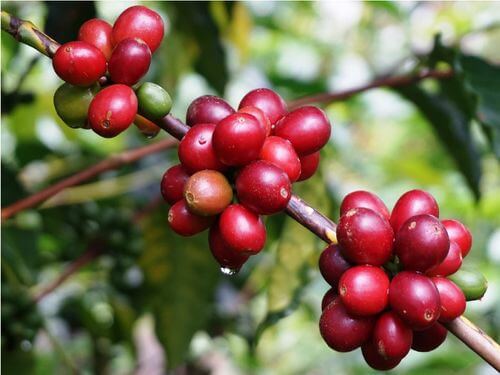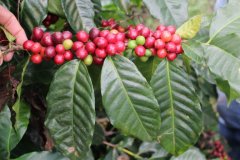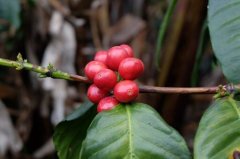The planting conditions, types and methods of coffee. What are the favorable conditions for coffee cultivation?

Professional coffee knowledge exchange more coffee bean information please follow the coffee workshop (Wechat official account cafe_style)
Growing conditions of coffee
Coffee can not be grown in any environment, because it is originally a plant growing in a tropical rain forest. In systematic development, coffee forms the habit of calm wind, cool, shaded or semi-shaded and humid environment. Therefore, coffee has strict requirements on planting conditions. We call the strips on both sides of the equator, between latitudes 25 degrees south and north, suitable for coffee growth as coffee belts.
Coffee belt
Temperature.
The temperature requirement varies with the cultivated species, and the small seed species are more hardy and prefer a warm and cool climate, requiring an average annual temperature of 1921 degrees.
Rainfall amount
Annual rainfall of more than 1250 mm, uniform distribution, especially in the flowering and young fruit development period, there is a certain amount of rainfall is most suitable for the growth and development of coffee.
Wind
Coffee prefers calm wind environment.
Light
Coffee is not resistant to strong light, needs proper shade, the light is too strong, and the growth is inhibited. If you add in the lack of water and fertilizer, there will be premature senility and even death. Excessive shade, long branches and leaves, few flowers and fruits, and low yield.
Soil.
Coffee has well-developed roots and shallow distribution of absorbing roots, which requires loose, fertile and well-drained loam.
Coffee trees can be divided into two main varieties: Arabica (Arabica) and Robusta (Robusta). There are also some minor species, such as the Liberian species (Liberica) and the Alabasta species (Arabusta), but they are rare on the market.
The coffee tree planted by Robusta can grow on flat land, it has strong resistance to disease and has high yield. Compared with Arabica beans, Robusta beans are more round in appearance, with a slightly inflated side with cracks in the middle, and straight grooves reminiscent of soybeans, while Arabica beans are oval and zigzag, a bit like half a peanut. Generally speaking, Robusta beans are poor in taste, have 2 to 3 times the caffeine content of Arabica beans, and are cheap, mostly for the large coffee industry to produce instant coffee or low-cost comprehensive products.
Arabica coffee trees are suitable for growing on fertile hillsides with good drainage at an altitude of about 1,000 to 2,000 meters. The climate should not be too humid, but they still need a continuous rainy season and abundant rainfall. During the day, they like mild temperatures and less than two hours of direct sunshine, so if there is a lack of afternoon showers or fog to report every day, local farmers have to plant many taller trees in the coffee garden for shade. At night, they want an environment of about ten degrees Celsius but not too low, because too warm will make the coffee berries grow too fast to produce small, strong, hard and high-quality coffee beans; in case it is too cold to frost, the coffee trees will freeze to death. Based on these characteristics, the promised land suitable for Arabica coffee is mostly located in countries with alpine terrain between the Tropic of Cancer, which is also known as the coffee belt.
The origin of the coffee tree is Ethiopia in Africa. In botany, coffee trees belong to the evergreen trees of the subgenus Rubiaceae, and coffee beans, commonly known as coffee beans, are actually the seeds of the fruit of coffee trees. They are called coffee beans only because they are shaped like beans. Climate is the decisive factor for coffee cultivation. Coffee trees are only suitable for growing in the tropics or subtropics, so the zone between latitude 25 degrees south and north is generally called coffee belt or coffee area. However, not all the land located in this area can produce good coffee trees.
1. Planting conditions of coffee trees.
The ideal planting conditions for coffee trees are as follows: the temperature is between 1500mm and 25mm, and the annual rainfall must reach 1500mm to 2000mm, and the rainfall time should be in line with the flowering cycle of coffee trees. Of course, in addition to the seasonal rainfall, there should also be fertile soil and good drainage. Rich soil containing volcanic ash, in addition, although sunlight is an indispensable element for the growth and fruiting of coffee, too strong sunlight will inhibit the growth of coffee trees, so various producing areas will usually cooperate with the planting of some shade trees. the ideal altitude is 500 to 2000 meters above sea level.
It can be seen that the conditions for the cultivation of high-quality coffee are quite strict: sunlight, rainfall, soil, air temperature, as well as the way coffee beans are harvested and the production process will affect the quality of coffee itself.
2. White flowers and red fruits
The first flowering period of the coffee tree is about three years old. the five-petal tube-shaped white flowers are filled with a faint scent of jasmine and the inflorescences are arranged in dense clusters. Flowers wither after two or three days of blooming and begin to bear fruit after a few months. The fruit is a drupe with a diameter of about 1.5 centimeters. it is green at first, then turns yellow gradually, turns red when ripe, and is very similar to cherries, so it is called cherry coffee and can be harvested at this time.
Coffee fruit contains two seeds, namely coffee beans. The two beans are connected face to face with each other on one side of the plane. Each coffee bean has a thin outer film, which is called silver skin, and its outer layer is covered with a yellow outer skin, called endocarp. The whole coffee bean is wrapped in a sticky pulp to form the coffee pulp, which is soft and sweet, with the outer shell.
Guide sharing
As a barista, in my lifetime, I will certainly look for a suitable opportunity to continue to fight on the stage. It's my bounden duty as a coffee warrior. The competition stage is my battlefield, coffee is my weapon, and I hope my professional life can bloom and wither on that stage. With their own practical actions, to those who pay attention to and support the development of Chinese baristas to convey a voice: Chinese baristas have been working hard, we can!
END
Important Notice :
前街咖啡 FrontStreet Coffee has moved to new addredd:
FrontStreet Coffee Address: 315,Donghua East Road,GuangZhou
Tel:020 38364473
- Prev

Coffee planting methods and steps growing environment and process tutorial _ can coffee trees be planted at home?
Professional coffee knowledge exchange more coffee bean information please pay attention to the coffee workshop (Wechat official account cafe_style) is there no coffee grown in Europe, how do coffee beans from Ethiopia, Colombia and Panama become so famous, what are the conditions for coffee cultivation, how is coffee planted, what is the process of production, and where is the quality coffee generally grown?
- Next

Is it okay to grow coffee in the north? are there any coffee trees adapted to the north? can coffee be grown in a greenhouse?
Professional coffee knowledge exchange more information about coffee beans Please follow the coffee workshop (official Wechat account cafe_style) Miss Fan, who was looking for beans in America a few days ago, shared photos of palm trees and big beaked bird estates. This is one of them. From a planting point of view, we call it compost, which means to put some unwanted biological waste in the manor, including coffee peel, waste branches, leaves.
Related
- Beginners will see the "Coffee pull flower" guide!
- What is the difference between ice blog purified milk and ordinary milk coffee?
- Why is the Philippines the largest producer of crops in Liberia?
- For coffee extraction, should the fine powder be retained?
- How does extracted espresso fill pressed powder? How much strength does it take to press the powder?
- How to make jasmine cold extract coffee? Is the jasmine + latte good?
- Will this little toy really make the coffee taste better? How does Lily Drip affect coffee extraction?
- Will the action of slapping the filter cup also affect coffee extraction?
- What's the difference between powder-to-water ratio and powder-to-liquid ratio?
- What is the Ethiopian local species? What does it have to do with Heirloom native species?

